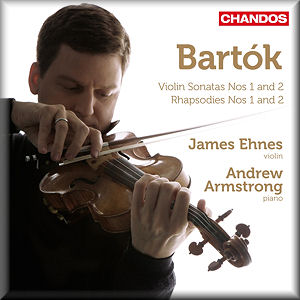 |
 |
|


alternatively
CD:
MDT
AmazonUK
AmazonUS
Downloads
from the Classical Shop
|
Béla BARTÓK (1881-1945)
Works for Violin and Piano - Vol. 1
Rhapsody No. 1, BB 94a (1928, revised 1929) [10:25]
Sonata No. 2, BB 85 (1922) [20:07]
Rhapsody No. 2, BB 96a (1928, revised 1945) [10:33]
Sonata No. 1, BB 84 (1921) [33:35]
Andante, BB 26b (1902) [4:00]
Rhapsody No. 1: Alternative Ending for Part II [1:48]
 James Ehnes (violin); Andrew Armstrong (piano)
James Ehnes (violin); Andrew Armstrong (piano)
rec. Potton Hall, Dunwich, Suffolk, England, 30 May-1 June 2011 DDD
 CHANDOS CHAN 10705 [80:30]
CHANDOS CHAN 10705 [80:30]
|
|
|
This very full CD is listed as volume 1. It will be curious
to see what’s left for a second volume, since his most famous
sonata is for violin alone. What we have here constitutes Bartók’s
essential works for the combination of violin and piano. It
must be acknowledged that the piano is of equal prominence to
the violin in these pieces, as least as far as the sonatas are
concerned. Of the four major works on the disc, the two rhapsodies
represent Bartók at his most approachable in his Hungarian folk
vein. The two sonatas are from his “wild and woolly” period
earlier in the 1920s. It may require several hearings to fully
appreciate their intricacies. The other work on the disc, the
early Andante, remained buried and forgotten until
1955 when its dedicatee, Adila Arányi Fachiri played it in a
London recital. It is pleasant enough in its songfulness, but
not at all representative of the composer. Violinist James Ehnes
has already gained a solid reputation as something of a Bartók
specialist with his recent recording of the violin and viola
concertos, a disc that I have not yet heard (also Chandos).
With this new recording, this reputation should be further enhanced.
However, I should emphasize that his piano partner, Andrew Armstrong,
need not take second billing either.
I found it interesting to compare the violin/piano versions
of the rhapsodies with those having an orchestral accompaniment.
While the orchestral versions may be more colorful, with the
use of the cimbalom in the First Rhapsody and the lower brass
in the Second Rhapsody, the piano part is also distinguished
and makes for a more equal partnership. The alternate ending
for the First Rhapsody listed above is the one more commonly
employed by violinists and familiar from the orchestral version.
It makes for a somewhat more exciting ending to the piece, while
the first ending brings back the main theme from the first movement
of the rhapsody. One could argue that it adds unity to the work.
On this recording you can program the CD so that you play the
last two tracks containing the alternate ending directly after
track two with only a tiny break while the player is switching
tracks.
Bartók dedicated his two sonatas for violin and piano to Jelly
d’Arányi, though he originally composed them for her sister,
Adila. Not only did he write the sonatas within the same period,
but also his concentration was such that he composed nothing
else at the time. The First Sonata is much longer than the Second
and contains three movements versus two for the latter. From
his extensive collecting of folk music, as well as the influence
of Stravinsky and Schoenberg, Bartók gained an appreciation
for atonality, something that became one of his hallmarks during
this period in his career. That’s not to say that they are all
that forbidding to the listener and there is even some of the
composer’s mordant humor in the finale of the Second Sonata.
As Paul Griffiths points out in his illuminating notes, Bartók’s
music in these sonatas was of “unusual density, struggle, and
complexity”, where “a pair of unalike virtuosos could pitch
themselves against each other”. Thus, like similar sonatas of
the composer’s forebears, namely Beethoven and Brahms, the piano
plays a role equal to that of the violin. Ehnes and Armstrong
make an excellent duo and perform these works as to the manner
born. If your main interest is in this particular program, I
doubt it could be bettered. If however, you want more variety,
I can point you towards a disc I reviewed
here a while ago, by the Norwegian artists, violinist Annar
Follesř, pianist Björn Nyman, and clarinetist Christian Ihle
Hadland on the 2L label. It includes the Solo Violin Sonata,
Sonata No. 2, and Contrasts. Their version of the Second Sonata
stands up well against the newcomers, too. I wait with curiosity
to see what volume two of this series brings. Meanwhile this
first volume is a strong contender for both programming and
performances.
Leslie Wright
|
|

